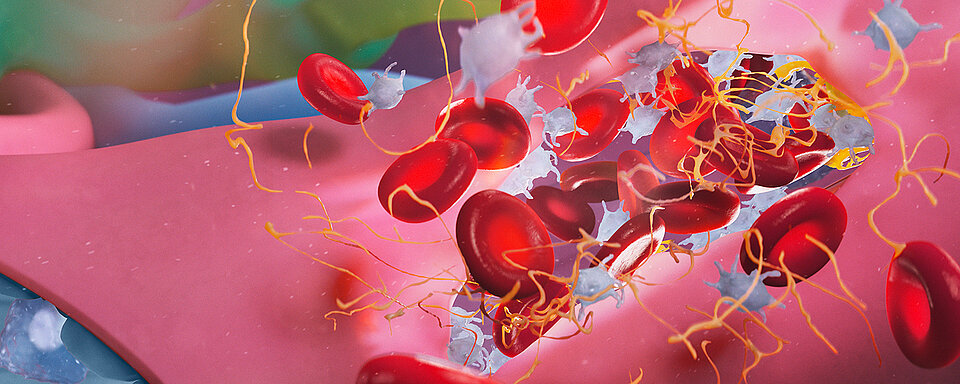Scientific Calendar December 2020
Diagnosis of factor XIII deficiencies
What special aspect has to be considered when determining the FXIII activity using an ammonia release assay?
In patients with a mild FXIII deficiency, a plasma blank with a factor XIIIa inhibitor must be performed in parallel to correct the FXIIIa-independent NAD(P)H consumption and the ammonia-producing processes in the patient sample.
In patients with a moderate and severe FXIII deficiency, a plasma blank with a factor XIIIa inhibitor must be performed in parallel to correct the FXIIIa-independent NAD(P)H consumption and the ammonia-producing processes in the patient sample.
In healthy individuals, a plasma blank with a factor XIIIa inhibitor must be performed in parallel to correct the FXIIIa-independent NAD(P)H consumption and the ammonia-producing processes in the patient sample.
Congratulations!
That's the correct answer!
Sorry! That´s not completely correct!
Please try again
Sorry! That's not the correct answer!
Please try again
Notice
Please select at least one answer
Scientific background
The plasmatic form of coagulation factor XIII is a pro-transglutaminase that plays a major role in the final stage of blood clot formation [1]. The zymogen plasma FXIII (pFXIII) has a tetrameric structure (FXIII-A2 B2) with two catalytic A subunits (FXIII-A) and two carrier/protective B subunits (FXIII-B) and is activated by thrombin and Ca2+. Thrombin cleaves the activation peptide from FXIII-A and then dissociates the A and B subunits in the presence of Ca2+. The cleaved FXIII-A dimer is thereby converted into an active transglutaminase (activated FXIII, FXIIIa). FXIIIa covalently crosslinks fibrin polymers and alpha 2-antiplasmin to a fibrin net that is resistant to shear stress and protected from the fibrinolytic enzyme plasmin.
Congenital FXIII‐A deficiency is a rare bleeding disorder that affects one individual in 1–3 million [2, 3] and is classified into two different types:
- Type I deficiency – a quantitative defect resulting from decreased synthesis of the protein
- Type II deficiency – a normal or near‐normal concentration of functionally defective FXIII‐A
Severe congenital FXIII‐A deficiency may cause severe bleeding events like intracranial haemorrhage, bleeding in muscles and subcutaneous soft tissues. Bleeding after trauma or surgery, caused by instability and early lysis of the clot, is particularly characteristic for an FXIII-A deficiency as well as repeated spontaneous abortions. Heterozygous cases with activity levels of around 30–60% are difficult to identify by symptoms alone. Problems often only arise in connection with surgery, tooth extractions or menorrhagia. Severe FXIII-B deficiency is very rare and is associated with milder bleeding symptoms than in patients with FXIII-A deficiency [4].
Acquired FXIII deficiency is more frequent than congenital deficiency and can appear in several medical conditions, such as major surgery, pulmonary embolism, stroke, leukaemia, liver cirrhosis, sepsis and disseminated intravascular coagulopathy (DIC). The values of the FXIII-A subunit decrease to a level of 20–70%, due to decreased synthesis or consumption.
Another cause of severe FXIII deficiency are autoantibodies that inhibit FXIII activation or FXIIIa activity [2]. In the majority of cases, the autoantibody developed in patients with systemic lupus erythematosus (SLE), though also with other autoimmune or malignant diseases as well as a side effect of certain drugs. It may occur spontaneously in elderly patients.
An important aspect in patients with a deficiency of FXIII is that the lack of fibrin cross-linking can also limit the formation of D-dimers (fibrin breakdown products cross-linked by FXIIIa), so that the usually informative D-dimer value is no longer reliable.
A first step in the diagnosis of factor XIII deficiency is the exclusion of other concomitant disorders of the clotting system, such as von Willebrand disease (VWD) or haemophilia. Basic screening assays for haemorrhagic disorders, like prothrombin time or activated partial thromboplastin time, are usually not abnormal in FXIII-deficient patients and may indicate the FXIII deficiency in the presence of clinical symptoms of a bleeding diathesis.
The SSC of the ISTH published an algorithm for the diagnosis and classification of FXIII deficiencies in 2011. The algorithm includes both activity and antigen assays as well as genetic assays [5].
Quantitative FXIII activity assays are based on two different measurement principles:
a) The measurement of labelled amine incorporated into protein substrate
b) The measurement of ammonia released during the reaction
Amine incorporation assays are more sensitive than ammonia release assays, but lack standardisation, are more time-consuming and less frequently automated.
The benefits of ammonia release assays are their short turnaround time, their true kinetics and the ability to use them on fully automated analysers. However, one major disadvantage is the comparably low sensitivity and relatively high limit of quantification (between 3 and 5% of the norm depending on the reagent used). Furthermore, ammonia release assays may overestimate the patient’s FXIII activity, caused by an FXIIIa-independent decomposition of NAD(P)H during the measurement by the patient’s enzymes like LDH or the FXIIIa-independent ammonia production in the plasma samples. This results in non-specific NAD(P)H consumption. While the overestimation by FXIIIa-independent factors is negligible in healthy individuals and patients with a mild FXIII deficiency, a misclassification may occur in patients with a moderate (FXIII ≤ 10% of the norm) or severe deficiency [6, 7].
In patients with moderate or severe factor XIII deficiency, the factor XIII activity for each patient should therefore be determined by a parallel plasma blank measurement so that the FXIIIa-independent NAD(P)H consumption and the ammonia-producing processes are corrected. Some reagent manufacturers provide such a blank reagent as part of the FXIII reagent kit. However, if the manufacturer's blank reagent is not available, a plasma blank should be made with a factor XIIIa inhibitor such as iodoacetamide [5].
If the plasma FXIII activity is decreased, the subtype of FXIII deficiency must be established by measuring the FXIII-A2B2 antigen concentration in the plasma. Further investigations of the FXIII-A and FXIII-B antigen levels must be carried out if the FXIII-A2B2 antigen concentration is decreased. Additional measurements of FXIII activity and FXIII-A antigen in platelet lysate are recommended as well.
The presence of autoantibodies against FXIII subunits must be evaluated by performing a mixing study to detect neutralizing antibodies against FXIII-A and binding assays to detect non-neutralizing antibodies against FXIII-A and FXIII-B [5].
The results of the FXIII determination must always be interpreted in the context of other coagulation values, here in particular platelets and fibrinogen, though also the level of alpha 2-antiplasmin (all potential substrates for FXIIIa). Genetic tests for typing the congenital deficiency are advantageous due to the large number of FXIII mutations [5].
References
[1] Komaromi I, Bagoly Z, Muszbek L. Factor XIII: novel structural and functional aspects. J Thromb Haemost 2011; 9: 9–20.
[2] Karimi M, Bereczky Z, Cohan N, Muszbek L. Factor XIII deficiency. Semin Thromb Hemost 2009; 35: 426–38.
[3] Ivaskevicius V, Seitz R, Kohler HP, Schroeder V, Muszbek L, Ariens RA, Seifried E, Oldenburg J; Study Group. International registry on factor XIII deficiency: a basis formed mostly on European data. J Thromb Haemost 2007; 97: 914–21.
[4] Ichinose A. Physiopathology and regulation of factor XIII. J Thromb Haemost 2001; 86: 57–65.
[5] Kohler HP, Ichinose A, Seitz R, Ariens RAS, Muszbek L on behalf of the factor XIII and fibrinogen SSC subcommittee of the ISTH. Diagnosis and classification of factor XIII deficiencies. J Thromb Haemost 2011; 9: 1404–06.
[6] Lawrie AS, Green L, Mackie IJ, Liesner R, Machin SJ, Peyvandi F. Factor XIII – an under diagnosed deficiency – are we using the right assays? J Thromb Haemost 2010; 8: 2478–82.
[7] Ajzner E, Muszbek L. Prophylactic and perioperative replacement therapy for acquired factor XIII deficiency: a rebuttal. J Thromb Haemost 2004; 2: 2075–7.

